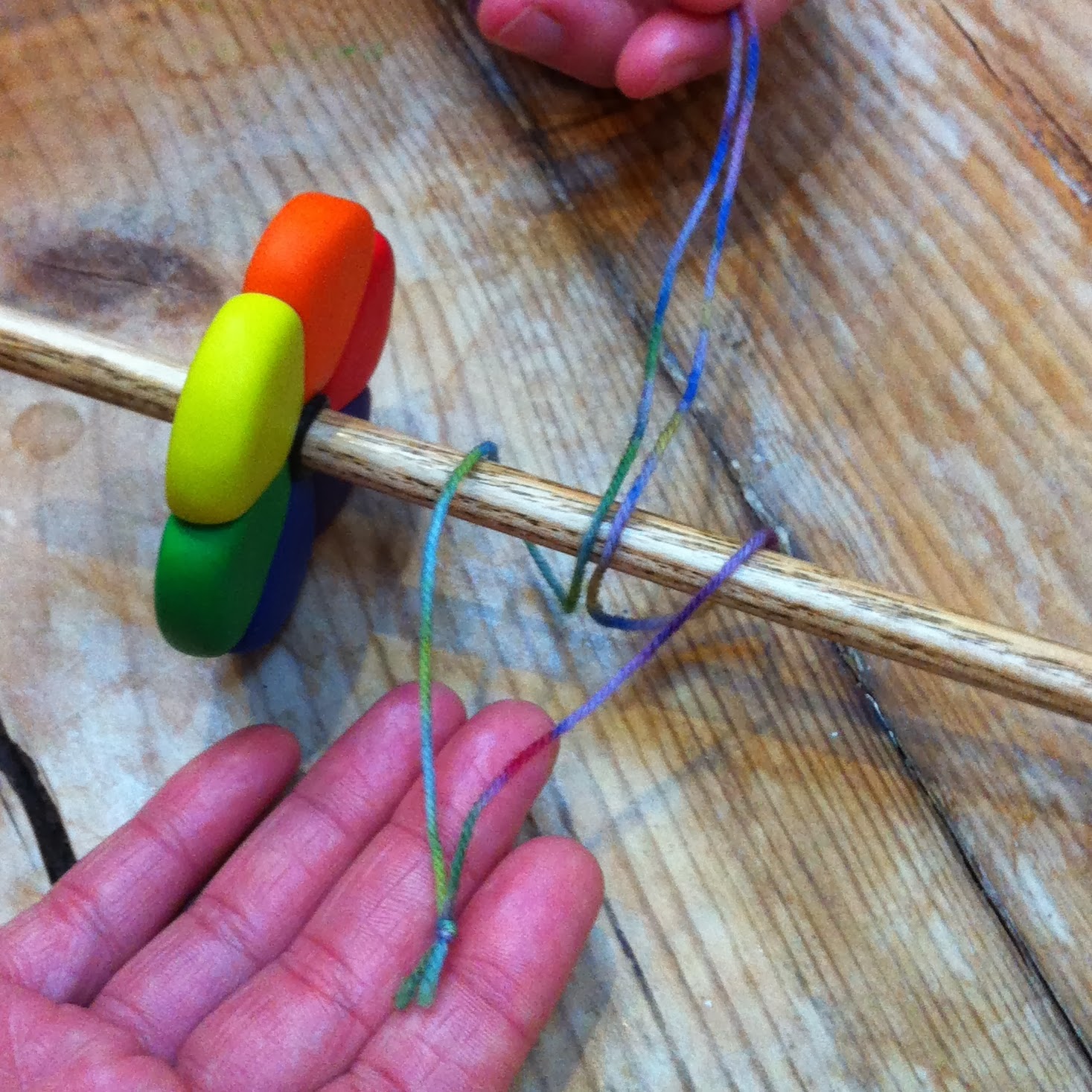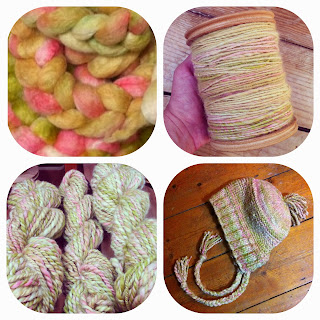Today, I am delighted to be guest blogging for Sarah of
Crafts from the Cwtch on her '
Spinning Show & Tell' weekly spinning meme.
When Sarah emailed to say she was going on holiday and would I like to write a guest post on spinning I jumped at the chance. I decided straight away that I would attempt something outside of my comfort zone for the project with a 'show & tell' style blog post for Sarah, and a more in depth 'how-to' for my blog.
I have been spinning since 2009 and have, to date, focused on the attainment of a good conventional and functional yarn. I have been mostly stuck in 2-ply Yarn Land, practicing a variety of yarn weights and using a variety of animal fibers. There is absolutely nothing wrong with a perpetual desire to spin
the most even and perfect skein of yarn, but after completing 2-ply skein number 11 at the close of the Tour de Fleece last month, I made a personal and conscious decision to try something new.
With a burgeoning desire to broaden my spinning horizons I took to Instagram, YouTube and new spinning magazine
PLY for inspiration.
Good old Ebay provided me with the raw materials for the project, which on this occasion was 100g of scoured Wensleydale locks, and 100g of Wensleydale top.
I began by spinning the whole 100g top as a singles yarn at an even(ish) sock/fingering weight.
The following evening, I prepared the locks by separating each one from the main bulk of fiber and laid them on my lap ready to incorporate into my spun singles.
Attaching the singles onto an empty bobbin via a leader yarn in such a way as to create the first loop needed for the Navajo or chain ply method, I was ready to go.
I began by plying a few feet of yarn to get myself into the swing of things, all the while feeling the excited anticipation of the addition of locks.
Having done a fair amount of online research about how to attach the locks to my yarn, I eventually chose to try a method where you push the top (sheared) end of the lock through the end of the loop created in the crochet chain type action of the Navajo ply. This secures the lock in place, and then you continue to ply down the length of the lock, leaving the curly tip to poke out at the bottom. If done correctly, the lock will then be completely anchored into place within the 3-ply yarn.
I continued on in this fashion, adding a new lock every (or every other) time I needed to perform a new ‘chain’ section of my ply.
As I have a normal flyer on my Ashford Joy spinning wheel, I sometimes had to feed the bulkier sections of yarn through the orifice and hooks by hand, but this was easily and quickly achieved.
Very soon I noticed that my bobbin was filling up nicely.
By the time the bobbin was full to capacity, I was feeling very jaded from a high level of sustained and complete concentration, so I left it where it was and called it a night.
First thing in the morning, I was excited to wind the yarn onto a niddy noddy and inspect my work.
So far so good. I really liked what I saw, but my fibery transformation wasn't over yet.
On to the dye job!
Securing the yarn in four places with white acrylic yarn using the figure of eight style, I took it off the niddy noddy and off for its first bath ... a nice half hour soak in luke warm water.
Meanwhile, I filled a large saucepan with one litre of water to which I added three tablespoons of citric acid, two 10g Sky Blue and two 10g Lime Green Dr. Oetker food colour gel tubes. I turned the hob on to a low heat and stirred until all the ingredients were completely dissolved.
After carefully squeezing out as much water as I could from my art yarn, I lowered it into the dye bath and turned up the heat to bring up to a gentle simmer.
I allowed the pot to simmer away for approximately twenty minutes until I was content that the yarn had taken up as much of the dye as it needed. Having used this food colour to dye fiber before, I knew that it doesn't completely absorb all the colour as is usually recommended. The green gel colour tends to leave a yellow in the water that doesn't take to the fiber easily. As I didn’t want the yarn to become a felted mass, I took the pot off the heat and let it stand for a couple of hours.
Once completely cool, I was able to take the yarn for another soak; This time in a weak detergent bath. Then a rinse to wash any excess dye and soap suds away. Next rolling it up in a nice dry towel, standing on it to squeeze out as much fluid as possible, and then I hung it up to dry with a big smile all over my face.
By early evening the same day, the yarn was dry and I took great satisfaction in re-skeining it for a photo shoot.
I am immensely happy with how this yarn has turned out, in so much as I had an idea of how I wanted this yarn to look in my best case scenario imagination, and I’m pleasantly surprised by the fruits of my labour.
Will I use this yarn as yarn? ... Maybe.
Will I admire it, have it out on show and stroke it a whole lot? ... Oh yes!
So I guess that what I’m saying is that there’s no need to fear spinning, in any of its guises. If you are spinning-curious then you can look to purchase a drop spindle spinning kit and get started creating your very own yarn.
And if you have already started this wonderful craft and are feeling the need to progress on to different methods, I’d say GO FOR IT. I wholeheartedly recommend that if you admire a certain look, texture or colour of yarn, then go out and make it happen ... fearlessly.
Play with different fibers ... animal, vegetable and synthetic ... research different ways of creating yarns in a variety of textures, colours and sizes.
I can assure you it’s a whole lot of fun, with a heaped tablespoon of creative satisfaction on the top.
*******
Many thanks for reading.
I'd love to hear from you if you've been inspired to try something new too :)

















































